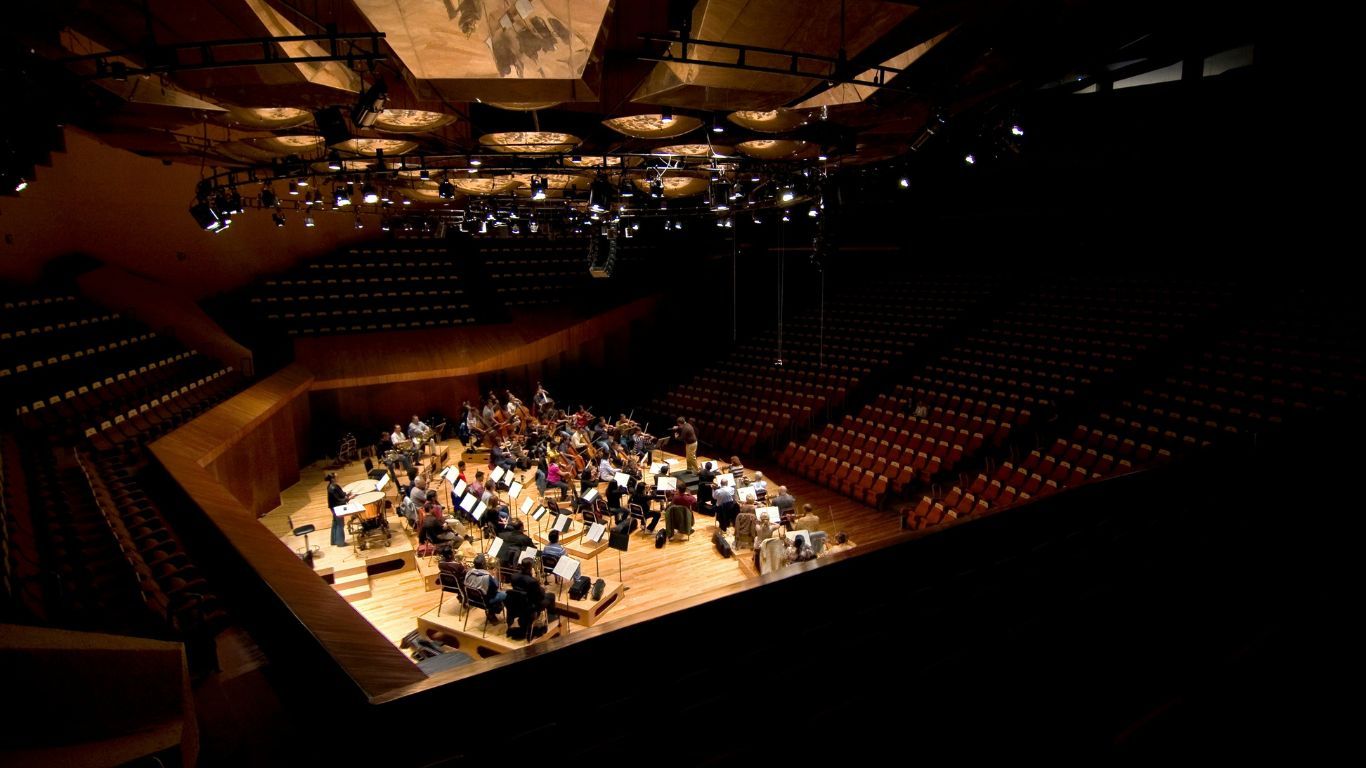
The structure of a symphony orchestra - Everything from instruments to performance
A symphony orchestra is a meticulously structured ensemble in which each component plays a vital role in shaping the overall sound. From violins to brass, each instrument is precisely positioned to achieve perfect balance and projection. But this structure is not just a matter of tradition, but rather a carefully designed system that allows an orchestra to function as a singular unit, in unison.
Understanding the structure of a symphony orchestra reveals the inner workings of classical music’s most powerful ensemble, one in which individual talent fuses into a breathtaking sonic experience.
The instruments of a symphony orchestra
The symphony orchestra is divided into four main sections: strings, winds, brass and percussion. Each section contributes to the overall sound of the orchestra and has its own unique characteristics.
1. Stringed instruments:
The string section is the largest and most essential part of the orchestra. It usually includes the following instruments:
- Violins – divided into two groups, first and second violins, they often play the main melody and provide harmonic support;
- Violas – slightly larger than the violins, they produce a richer, deeper sound and often play inner harmonies;
- Violoncellos – with their full, warm tones, violins provide both melody and harmony, bridging the high and low sounds;
- Double basses – the largest and lowest stringed instruments, double basses add depth and foundation to the orchestral sound;
- Harp – although not always included, the harp adds a unique, ethereal texture with its plucked strings.
2. Woodwind instruments:
The woodwind section adds color and complexity to the orchestra. This includes:
- Flutes – known for their open and clear sound, flutes often play melodies and high harmonies;
- Piccolo flute – a smaller, sharper version of the flute that adds brilliance to orchestral textures;
- Oboes – with a piercing, nasal tone, oboes are frequently used for expressive, lyrical lines;
- English Horn – an alto oboe with a deeper, more melancholy sound;
- Clarinets – versatile in range and tone, clarinets can play melodic and harmonic roles;
- Bass clarinet – a clarinet with extended range that adds depth to the woodwind section;
- Bassoons – the lowest of the woodwind instruments, the bassoon provides a rich, reed-voiced sound that supports the bass line;
- Contrabassoon – an even lower-pitched bassoon that provides deep bass notes.
3. Brass instruments:
The brass section is known for its powerful, resonant sound. This includes:
- French horn – with a rich, mellow tone, French horns can play melodic and harmonic roles.
- Trumpets – bright and piercing, trumpets often play fanfare and prominent melodic lines.
- Trombones – known for their robust and versatile sound, trombones can play both melodic and bass lines.
- Tubas – the lowest brass instruments, tubas provide a solid foundation in the bass register
4. Percussion instruments:
The percussion section adds rhythm and texture to the orchestra. This includes a wide variety of instruments:
- Timpani – also known as kettle drums, timpani are tuned to specific pitches and play rhythmic and melodic roles;
- Bass drum – a sharp, clear drum used for rhythmic patterns;
- Bass drum – a large drum that provides deep, resonant beats;
- Chimes – metal plates that are bumped or struck to add dramatic accents;
- Triangle – a small, triangular metal instrument that produces a bright, tinkling sound;
- Xylophone – a wooden percussion instrument with a bright, melodic sound;
- Marimba, vibraphone and glockenspiel – other sharp percussion instruments that add unique timbres;
- Tambourine, castanets and maracas – hand percussion instruments that add rhythm.
The structure of a symphony orchestra
The structure of a symphony orchestra is hierarchical and well-defined, ensuring good coordination and performance. Here is a detailed overview of its structure:
1. The conductor
The conductor is the leader of the orchestra, responsible for interpreting the music and conducting the performance. He or she uses a baton to keep the rhythm and indicate the different sections, making sure that all the musicians play in synchronization. The conductor’s role is crucial in maintaining cohesion and achieving the desired musical expression.
2. Concertmaster
The concertmaster is the principal violinist and second in command after the conductor. He/she plays the first violin part and often serves as a liaison between the conductor and the musicians. The Concertmaster is also responsible for tuning the orchestra before performances.
3. Section Conductors
Each section (strings, winds, brass and percussion) has a section leader who is responsible for coordinating the musicians in that section. Section leaders ensure that their group plays together and follows the conductor’s instructions.
4. Musicians
The musicians are the backbone of the orchestra. They are highly skilled instrumentalists who must blend their individual sounds into a coherent whole. Each musician must be skilled in both solo and ensemble playing.
5. Seating Arrangement
A symphony orchestra’s seating arrangement is designed to optimize the blend and balance of sound. Typically, the strings are seated at the front, with the first violin to the left, the second violin to the right, the violin in the middle, and the cello and double bass at the back. The woodwinds are positioned behind the strings, followed by the brass and finally the percussion in the back.
Playing practices
The performance practices of a symphony orchestra are shaped by tradition, the vision of the conductor and the demands of the repertoire. Here are some key aspects of orchestral performance:
1. Rehearsals
Rehearsals are essential in preparing a symphony orchestra for a performance. During rehearsals, the conductor works with the musicians to fine-tune the performance, solve technical problems and ensure cohesion. Rehearsals may be extended, especially for complex works.
2. Interpretation
The conductor plays an important role in shaping the interpretation of the music. He or she makes decisions about tempo, dynamics, phrasing and articulation, guiding the orchestra to achieve a unified performance. Each conductor brings a unique perspective to the music, making each performance distinctive.
3. Dynamics and expression
Dynamics (loudness) and expression are essential elements of orchestral performance. Musicians must pay close attention to the score markings and the conductor’s cues, ensuring that the music is expressive and dynamic. Crescendoes, decrescendoes and sudden changes in volume add theatricality and intensity to the performance.
4. Balance and blend
Achieving a balanced and blended sound is vital for a symphony orchestra. Musicians must listen carefully to each other and adjust their playing to ensure that no one section overwhelms the others. The conductor helps maintain balance by making sure all parts are heard clearly.
5. Solo and ensemble performance
While the orchestra functions primarily as an ensemble, there are times when individual musicians or sections are featured as soloists. These solo passages require the soloists to project their sound and convey musical expression, while the rest of the orchestra provides the supporting accompaniment.
6. Concert etiquette
Concert etiquette is an important aspect of orchestral performance. Musicians must dress formally, usually in black, and follow specific protocols for entering and exiting the stage. Applause is expected at the end of each piece or movement, and musicians must acknowledge the audience’s appreciation by bowing.
7. Repertoire
The repertoire of a symphony orchestra is vast and varied, spanning many centuries and styles. It includes symphonies, concertos, overtures and suites by composers from the Baroque, Classical, Romantic and Modern eras. The orchestras also perform contemporary works, film scores and popular music arrangements, demonstrating their versatility.
8. Collaboration with soloists and ensembles
Symphony orchestras often collaborate with soloists, such as pianists, violinists and singers, as well as smaller choirs and ensembles. These collaborations add diversity to the concert program and give musicians the opportunity to explore different musical genres and styles.
9. Recordings and broadcasts
In addition to live performances, symphony orchestras frequently engage in recording and broadcasting projects. Recordings capture the orchestra’s artistry and allow the music to reach a wider audience. Broadcasts, whether on radio, television or online platforms, bring the live concert experience to listeners and viewers around the world.
A symphony orchestra is an extraordinary work of precision, craftsmanship and collaboration. Each instrument, from the delicate first violin to the stately timpani, has a distinct role, yet no section is isolated. The structured arrangement, carefully crafted to balance sound and projection, allows the dozens of musicians to play as a unified whole under the conductor’s guidance.
Beyond the technical structure, an orchestra is a living entity, one in which tradition meets innovation and in which each musician’s talent coalesces into something much greater than the sum of its parts.
Whether listening from the audience or playing in its ranks, the orchestra remains one of the most powerful expressions of human creativity, demonstrating that true musical magic happens when harmony, discipline and passion come together.

